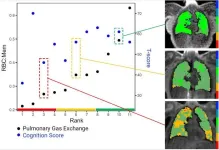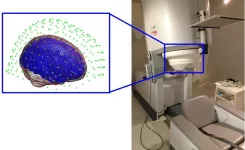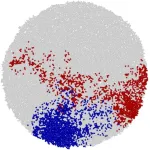(Press-News.org) Imagine gradually losing the ability to express yourself — not because you've forgotten the words, but because they simply won't come out. This is the reality for individuals living with primary progressive aphasia (PPA), a rare form of dementia that usually begins in middle age and increasingly impairs language abilities over time.
Researchers at the University of Chicago Medicine are working to illuminate the struggles of those living with this condition and pioneer accessible treatment models. They recently published new studies that measure PPA’s significant impact on quality of life and demonstrate the feasibility of international telemedicine interventions — research that could reshape care delivery and inform policy decisions.
Understanding PPA
PPA is a unique neurological condition that primarily affects language skills, setting it apart from more common and well-known forms of dementia like Alzheimer's dementia that primarily impacts memory in the earliest stages.
“PPA is a relatively rare dementia,” said Emily Rogalski, PhD, the Rosalind Franklin PhD Professor of Neurology at UChicago and a leading researcher in the field. “It's often overlooked in the literature because it can be difficult to assemble large groups of people to survey lived experiences.”
She said it’s frequently overlooked by medical professionals as well, going undiagnosed particularly among those with lower socioeconomic status.
“Lack of diagnosis can be such a barrier to care for anyone not living next to a specialized medical center,” she said.
A feature that makes PPA especially challenging is its early onset.
“These individuals are at a different life stage from late-onset Alzheimer’s dementia patients,” Rogalski said. “They're often still in the prime of their working career; they may have young children in the home.”
This can mean PPA not only affects the patients but also has significant implications for their families, family relationships and economic stability.
Measuring PPA’s impact on quality of life
To better understand how PPA affects daily living, Rogalski and her collaborators conducted a study using the Health Utilities Index (HUI), a standardized tool that measures various aspects of well-being, including physical abilities, emotional health and cognitive functions.
Unsurprisingly to those familiar with the disease, the results showed that PPA has a moderate to severe negative impact on patients’ health-related quality of life. The results also showed that greater language impairment in individuals with PPA was linked to a lower quality of life, particularly affecting domains such as hearing, sensation, cognition and speech.
“It was important to confirm that the HUI, a commonly used health measure across diseases, was capturing the essence of these patients’ primary impairment,” Rogalski said.
Thomas Hopkins, PharmD, MS, the study’s first author, explained the study’s twofold purpose: obtaining detailed information about quality of life for individuals with PPA, and enabling direct, objective comparisons between the impact of PPA and that of other diseases. Since the Health Utilities Index is a generic measurement, it can be applied to any health condition — even those dissimilar to dementia, such as cardiovascular disease or cancer.
“When it comes to policy-making and government allocation of resources, it really is important to have these broadly applicable measures so better decisions can be made,” Hopkins said.
This quality-of-life data can inform crucial decisions including research funding and prioritization, insurance regulation, disability coverage and more. Now armed with concrete evidence that PPA can impact the lives of middle-aged adults just as dramatically as many other disruptive diseases, researchers, patients and families can advocate for more resources and support.
Expanding access to care with telemedicine
Even while working to establish objective measurements of PPA’s impact, Rogalski and her colleagues were simultaneously enrolling patients in a clinical trial exploring the feasibility of delivering speech-language therapy for PPA via telemedicine. They recently reported the successful enrollment of 95 participant pairs — each comprising a PPA patient and their primary caregiver — from four countries, demonstrating that remote recruitment and video chat intervention are viable options for overcoming geographic and socioeconomic barriers to treatment.
“We found a way to deliver care that creates a little bit more of an equal playing field,” Rogalski explained. “Persons with PPA don't have to be living next to a major academic medical center or specialty center to get in touch with an expert and receive treatment.”
This success also paves the way for future research and interventions — and not just for PPA.
“We see our approach as a potential model,” Rogalski said. “We think the framework we have can be adapted and used to support advocacy and interventions for multiple different dementia syndromes and conditions.”
Offering hope even in the absence of a cure
Rogalski points out that care partners play a crucial role in studies like these, providing essential insights into daily challenges and diverse needs that span family dynamics and life situations.
“We're giving families a voice to share their lived experiences,” she said.
Despite these research advancements, challenges remain in diagnosing and treating PPA, and no drug or therapy that can cure the disease has been developed yet. But broadening understanding of PPA’s profound impact on quality of life and demonstrating the effectiveness of telemedicine interventions are meaningful steps that can encourage patients and families.
“Providing hope and practical support for these families is really important,” Rogalski said. “Too many people have lived experiences in which, even when they find a specialist, that specialist may say, ‘There's nothing we can do. It's a terminal diagnosis.’ But finding a cure isn't the only way we can help people. Maximizing independence, emotional well-being, confidence — all of those things can have a lot of practical aspects on one's daily life. If we can ramp those up as much as possible while we're simultaneously looking for pharmacological solutions, that's a winning combination.”
To learn more about ongoing PPA studies and related research, visit the Healthy Aging & Alzheimer's Research Care (HAARC) Center website.
“Assessment of Disease Impact through Health-Related Quality of Life Measurement in Primary Progressive Aphasia” was published in Alzheimer's & Dementia: Translational Research & Clinical Interventions in November 2024. Authors include Thomas Hopkins, Eunbi Kwon, Allison Lapins, Nathan Gill, Angela Roberts and Emily Rogalski.
“Communication Bridge 2 Randomized Controlled Trial: Recruitment and Baseline Features” was published in Alzheimer's & Dementia: The Journal of the Alzheimer's Association in November 2024. Authors include Emily Rogalski, Matthew Bona, Marissa Esparza, Aimee Mooney, Melanie Fried-Oken, Alfred Rademaker and Angela Roberts.
END
Quantifying disease impact and overcoming practical treatment barriers for primary progressive aphasia
2024-11-26
ELSE PRESS RELEASES FROM THIS DATE:
Sports betting and financial market data show how people misinterpret new information in predictable ways
2024-11-26
Let’s say it’s a home game for the Golden State Warriors and Steph Curry shows he’s still got it, sinking back-to-back three-pointers minutes into the first quarter. The fans at Chase Center take notice, and so do the betting markets, where the odds move in the Warriors’ favor.
Yet it’s a long game. The away team comes back, and with just 10 seconds to go, the Warriors are down by two and have just missed a shot. A victory is unlikely, and the betting odds should have shifted to reflect that near-certainty. ...
Long COVID brain fog linked to lung function
2024-11-26
CHICAGO – In patients with long COVID, lower pulmonary gas exchange may be associated with impaired cognitive function, according to a study being presented next week at the annual meeting of the Radiological Society of North America (RSNA).
According to the National Center for Health Statistics, approximately 17.6% of adults in the U.S. have experienced a post-COVID condition commonly referred to as long COVID. People with long COVID may exhibit a wide variety of symptoms, including difficulty concentrating (“brain fog”), change in sense of smell or taste, fatigue, joint or muscle pain, dyspnea (shortness of breath), digestive ...
Concussions slow brain activity of high school football players
2024-11-26
CHICAGO – A new study of high school football players found that concussions affect an often-overlooked but important brain signal. The findings are being presented next week at the annual meeting of the Radiological Society of North America (RSNA).
Reports have emerged in recent years warning about the potential harms of youth contact sports on developing brains. Contact sports, including high school football, carry a risk of concussion. Symptoms of concussion commonly include cognitive disturbances, such as difficulty with balancing, ...
Study details how cancer cells fend off starvation and death from chemotherapy
2024-11-26
Laboratory experiments with cancer cells reveal two ways in which tumors evade drugs designed to starve and kill them, a new study shows.
While chemotherapies successfully treat cancers and extend patients’ lives, they are known not to work for everyone for long, as cancer cells rewire the process by which they convert fuel into energy (metabolism) to outmaneuver the drugs’ effects. Many of these drugs are so-called antimetabolics, disrupting cell processes needed for tumor growth and survival.
Three such drugs used in the study — raltitrexed, N-(phosphonacetyl)-l-aspartate (PALA), and brequinar ...
Transformation of UN SDGs only way forward for sustainable development
2024-11-26
Climate change is the single biggest threat to the global environment and socio-economic development – demanding an urgent transformation of the United Nations’ Sustainable Development Goals (SDGs), according to a new study.
The UN SDGs were created to end poverty, build social-economic-health protection and enhance education and job opportunities, while tackling climate change and providing environmental protection.
Following last week’s COP29 environmental summit in Baku, University of Birmingham experts say that, as climate action is linked to sustainable development, systematic integration of climate resilience into every ...
New study reveals genetic drivers of early onset type 2 diabetes in South Asians
2024-11-26
UNDER STRICT EMBARGO UNTIL 10.00AM (UK TIME) ON 26 NOVEMBER 2024
New study reveals genetic drivers of early onset type 2 diabetes in South Asians
Peer reviewed | Observational study | People
A genetic predisposition to having lower insulin production and less healthy fat distribution are major causes of early-onset type 2 diabetes in British Asian people. According to new research from Queen Mary University of London, these genetic factors also lead to quicker development of health complications, earlier need for insulin treatment, and a weaker response ...
Delay and pay: Tipping point costs quadruple after waiting
2024-11-26
RICHLAND, Wash. —Tip the first tile in a line of dominoes and you’ll set off a chain reaction, one tile falling after another. Cross a tipping point in the climate system and, similarly, you might spark a cascading set of consequences like hastened warming, rising sea levels and increasingly extreme weather.
It turns out there’s more to weigh than catastrophic environmental change as tipping points draw near, though. Another point to consider, a new study reveals, is the cost of undoing the damage.
The cost of reversing the effects of climate change—restoring melted polar sea ice, for ...
Magnetic tornado is stirring up the haze at Jupiter's poles
2024-11-26
While Jupiter's Great Red Spot has been a constant feature of the planet for centuries, University of California, Berkeley, astronomers have discovered equally large spots at the planet's north and south poles that appear and disappear seemingly at random.
The Earth-size ovals, which are visible only at ultraviolet wavelengths, are embedded in layers of stratospheric haze that cap the planet's poles. The dark ovals, when seen, are almost always located just below the bright auroral zones at each ...
Cancers grow uniformly throughout their mass
2024-11-26
Researchers at the University of Cologne and the Centre for Genomic Regulation (CRG) in Barcelona have discovered that cancer grows uniformly throughout its mass, rather than at the outer edges. The work, published today in the journal eLIFE, challenges decades-old assumptions about how the disease grows and spreads.
“We challenge the idea that a tumour is a ‘two-speed’ entity with rapidly dividing cells on the surface and slower activity in the core. Instead, we show they are uniformly growing masses, where every region is equally active and has the potential ...
Researchers show complex relationship between Arctic warming and Arctic dust
2024-11-26
The Arctic is warming two to four times faster than the global average. A recent study by researchers in Japan found that dust from snow- and ice-free areas of the Arctic may be an important contributor to climate change in the region. The findings were published in the journal npj Climate and Atmospheric Science.
According to one view, higher temperatures in the Arctic are thought to lead to the region's clouds containing more liquid droplets and fewer ice crystals. Clouds become thicker, longer lasting, ...




